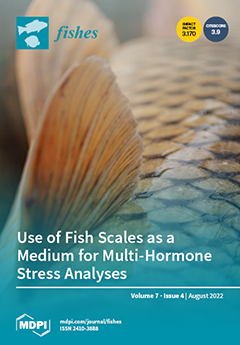The effects of various levels of alkalinity stress (0, 18.25, 35.41, 52.53 and 69.74 mmol/L) in Chinese mitten crab (
Eriocheir sinensis) were investigated by means of measuring hepatopancreas antioxidant system and serum nonspecific immune system-related indices at 0, 12, 24, 48
[...] Read more.
The effects of various levels of alkalinity stress (0, 18.25, 35.41, 52.53 and 69.74 mmol/L) in Chinese mitten crab (
Eriocheir sinensis) were investigated by means of measuring hepatopancreas antioxidant system and serum nonspecific immune system-related indices at 0, 12, 24, 48 and 96 h, hepatopancreas tissue structure at 96 h. The activities of superoxide dismutase (SOD), catalase (CAT), glutathione (GSH) and aspartate aminotransferase (AST) in each concentration group generally showed a trend of a first increasing and then decreasing during the 96-h stress process (
p < 0.05), while no significant changes were observed in the blank group during this period (
p > 0.05). The activities of CAT, GSH and AST in all treatment reached peak values at 24–48 h. At 96 h of alkalinity stress, the activities of GSH, alanine aminotransferase (ALT), acid phosphatise (ACP) and alkaline phosphatise (AKP) in the 18.25 mmol/L group were not significantly different with the control group (
p > 0.05). The activities of SOD and CAT in the 52.53 and 69.74 mmol/L treatment were significantly lower than those in the control group (
p < 0.05), and the level of total antioxidant capacity(T-AOC), ALT, ACP and AKP in the 69.74 mmol/L group were significantly higher than those in the other groups (
p < 0.05). Hepatopancreatic histological observation showed that the hepatopancreas of
E. sinensis in the control group was normal. With increasing alkalinity, the basal membrane of the hepatopancreas fell off or even ruptured. Additionally, the number of hepatopancreas vacuoles increased, the volume of B cells and their internal transport vesicles increased, epithelial cells disintegrated, and the nucleus gradually shrank.
E. sinensis can activate antioxidant and nonspecific immune systems to adapt to alkalinity stress. However, oxidative stress, immune system damage and hepatopancreas structure damage were caused when the stress exceeded the adaptive capacity of the body.
Full article





